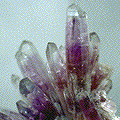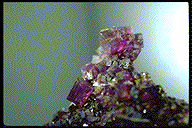What is a mineral? A mineral is (generally) an inorganic, naturally occurring, organized crystalline structure composed of a single chemical compound or element.
What is a rock? A rock is (generally) a natural solid composed of multiple crystals of one or more minerals. Although many rocks contain visible crystals of individual minerals, a rock itself does not have an overall crystalline structure.
What is a crystal? A crystal is an orderly arrangement of molecules formed because the component atoms and ions tend to aggregate together in certain specific patterns. Sometimes very different minerals are formed from the same starting materials (such as diamond versus graphite, both pure carbon) as determined by the temperature, pressure, or other conditions of formation. These arrangements result in the crystal forms described in the physical characteristics pages. Often, minerals are formed as a solution changes in some way which allows or forces the component mineral(s) to solidify or precipitate out of solution. This change may be temperature, pressure, chemistry, or concentration, and the solution may be aqueous or a magma (or even a gas, as sulfur crystals may condense from vapors emitted by a volcanic fumerol, and snowflakes precipitate from air). A slow solidification or precipitation supports the growth of larger crystals. Note that this process is responsible for much of the mineral segregation that gives us ores, as well as all of the gemstones we admire. Crystals may be too small to see, as in agate, or incredibly large - see our Gypsum page for an astounding example. Of course, not all solids are crystalline. Very rapid cooling of a molten compound can result in a glass, where the individual molecules have random orientations, not the orderly arrangements found in a crystal.
Before the Earth was formed, before igneous or sedimentary or metamorphic rocks were even possible, there were primordial rocks and primordial minerals. In the early solar system these condensed directly from the solar nebula, and are visible today as asteroids and comets in space, and as meteorites on Earth. Indeed, the number of distinct minerals appears to have increased over time: see The Evolution of Minerals.
*** NOTICE ***We are transitioning to a new, cloud-based web site. Basic functionality, including all mineral, rock, and informational pages should be working. Some progress has been made in updating the site to support a wide variety of platforms; I am aware of some issues, including limited phone functionality (but my phone mostly works well). Also, the new server is case sensitive, so I am converting all directories and pages to lower case, which is likely to cause some issues. Also, over the years, I have used rewrite rules to make user-friendly mineral names work, but that functionality has changed, and fixing it will require additional steps. Searches and database (mineral specimen) functionality has been implemented using Google Site Search. Please let me know about problems. We are in the process of displaying our mineral specimens database on each applicable page. Not all specimens are shown, and for reasons unknown, some images are missing. I'm working on it! We no longer sell mineral specimens, so the displays are of previously-sold specimens for general information. Thank you for your patience and understanding as I find and fix the remaining problems. Please email me (coveysd@galleries.com) if you find a page that should be corrected ASAP.
Amethyst Galleries' Mineral Gallery describes over 600 mineral species and 6,000 specimens, together with several ways of accessing these descriptions. The descriptions include searchable mineralogical data, plus other information of interest to students and rock hounds. This site displays thousands of images of previously sold mineral specimens as a service to rockhounds, students and educators. We were the first rock shop on the Internet, going live (with a numeric IP address) in the fall of 1994, and under the domain galleries.com in the spring of 1995. See our History page for additional information.
We apologize if any of the ads displayed on our site seem inappropriate. While most are properly related to gemstones, minerals, and rocks, we can't control which keywords the advertisers target, plus this site is very popular (peaking at over 300,000 visitors per month) and is chosen by hundreds of advertisers who seek customers such as you. Google has chosen to present ads based upon past searches conducted by visitors such as you, and those ads also have nothing to do with this site. Feel free to give Google feedback via the "Feedback - Ads by Google" link at the corner of many of their ads.
Note that, for your convenience, the ads and menus will not display in printed pages for modern browsers.
About Amethyst Galleries, Inc.:
To learn more about this service, check out our About page!
You may contact
us by e-mail as follows:
- General rock and mineral questions or comments for the webmaster: coveysd@galleries.com
A few other links of interest:
- See our Privacy, Security, Honesty, and Accuracy policies.
- To see the entire list of the mineral species currently in our database, see this version of Minerals by Name (about 600 mineral species and varieties).
- To learn a little about our company, see the Amethyst Galleries page, and the History page.
- To learn who is responsible for the Mineral Gallery, see our credits page, which includes the owner:
- Stephen Covey who created and manages the website while writing Techno-thrillers and Science Fiction, and blogging at Ramblings On The Future Of Humanity
- See this list of our favorite rock, mineral
and gem books.










